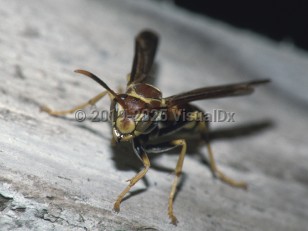Hornet sting
Alerts and Notices
Important News & Links
Synopsis

Hornets (Vespa species) are large wasps that are related to yellow jackets (Vespula and Dolichovespula species) and paper wasps (Polistes species). They are social insects native to the northern temperate zone of the Eastern Hemisphere, except for one European species (Vespa crabro) that was introduced into the United States in the early 1800s and is now established, though uncommon, in eastern North America.
Wasp stings are the most common human envenomation. The stings from all species are similar, but hypersensitivity reactions may be quite specific. Hornets can sting repeatedly, especially when trapped in clothing, because their stingers do not have barbs like some bees.
Hornet venom is similar to bee venom, but the venoms are generally not cross-reactive. Hornet venom contains enzymes, small peptides, and amines. The allergens include the phospholipases, hyaluronidases, and cholinesterases. Some peptides cause histamine release by degranulating mast cells. Histamine, serotonin, and acetylcholine contribute to the pain associated with hornet stings.
Hornet sting toxicity varies greatly by hornet species. The European hornet sting is less toxic than a bee sting but may be fatal in a sensitized individual or with multiple stings (several hundred). Non-European hornet stings are more toxic than other wasps or bee stings and, in fact, the Asian giant hornet is the most venomous known insect (per sting); multiple stings have been associated with kidney disease and even death in China.
Local hornet sting reactions include immediate pain, swelling, and redness at the sting site that often subsides within a few hours.
Regional reactions (exaggerated local reactions) occur in some individuals with extended swelling that can last 2-7 days. These reactions are not allergic in origin.
Anaphylactic reactions cause diffuse urticaria, pruritus, angioedema, bronchoconstriction, respiratory distress, hypotension, loss of consciousness, and cardiac arrhythmias. Typically, within 10 minutes of the sting, onset of life-threatening, anaphylactic signs will occur.
Acute myocardial infarction, hepatitis, intravascular hemolysis, rhabdomyolysis, acute renal failure, and glomerulonephritis following wasp stings have been rarely reported.
Wasp stings are the most common human envenomation. The stings from all species are similar, but hypersensitivity reactions may be quite specific. Hornets can sting repeatedly, especially when trapped in clothing, because their stingers do not have barbs like some bees.
Hornet venom is similar to bee venom, but the venoms are generally not cross-reactive. Hornet venom contains enzymes, small peptides, and amines. The allergens include the phospholipases, hyaluronidases, and cholinesterases. Some peptides cause histamine release by degranulating mast cells. Histamine, serotonin, and acetylcholine contribute to the pain associated with hornet stings.
Hornet sting toxicity varies greatly by hornet species. The European hornet sting is less toxic than a bee sting but may be fatal in a sensitized individual or with multiple stings (several hundred). Non-European hornet stings are more toxic than other wasps or bee stings and, in fact, the Asian giant hornet is the most venomous known insect (per sting); multiple stings have been associated with kidney disease and even death in China.
Local hornet sting reactions include immediate pain, swelling, and redness at the sting site that often subsides within a few hours.
Regional reactions (exaggerated local reactions) occur in some individuals with extended swelling that can last 2-7 days. These reactions are not allergic in origin.
Anaphylactic reactions cause diffuse urticaria, pruritus, angioedema, bronchoconstriction, respiratory distress, hypotension, loss of consciousness, and cardiac arrhythmias. Typically, within 10 minutes of the sting, onset of life-threatening, anaphylactic signs will occur.
Acute myocardial infarction, hepatitis, intravascular hemolysis, rhabdomyolysis, acute renal failure, and glomerulonephritis following wasp stings have been rarely reported.
Codes
ICD10CM:
T63.451A – Toxic effect of venom of hornets, accidental, initial encounter
SNOMEDCT:
307427009 – Hornet sting
T63.451A – Toxic effect of venom of hornets, accidental, initial encounter
SNOMEDCT:
307427009 – Hornet sting
Look For
Subscription Required
Diagnostic Pearls
Subscription Required
Differential Diagnosis & Pitfalls

To perform a comparison, select diagnoses from the classic differential
Subscription Required
Best Tests
Subscription Required
Management Pearls
Subscription Required
Therapy
Subscription Required
References
Subscription Required
Last Updated:05/11/2020
 Patient Information for Hornet sting
Patient Information for Hornet sting
Premium Feature
VisualDx Patient Handouts
Available in the Elite package
- Improve treatment compliance
- Reduce after-hours questions
- Increase patient engagement and satisfaction
- Written in clear, easy-to-understand language. No confusing jargon.
- Available in English and Spanish
- Print out or email directly to your patient
Upgrade Today

Hornet sting

